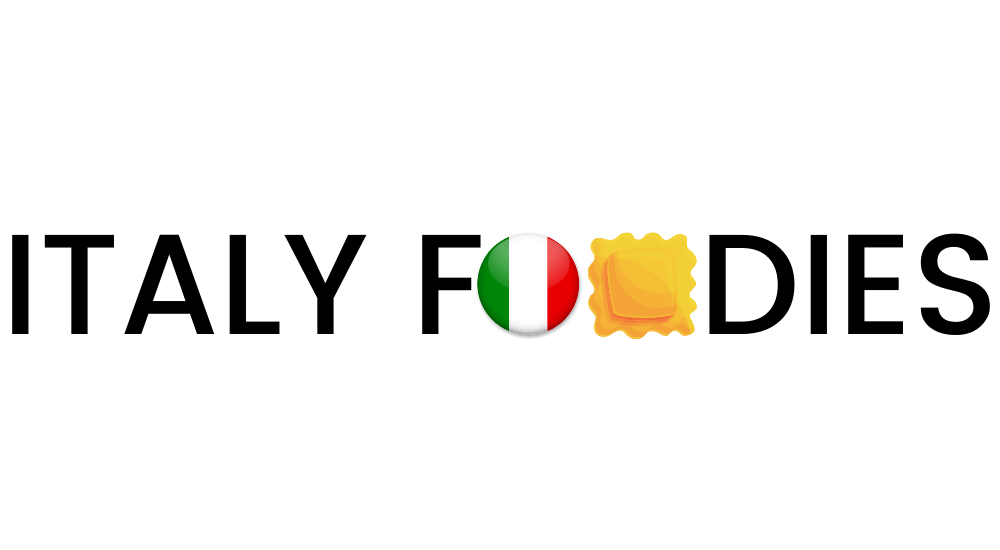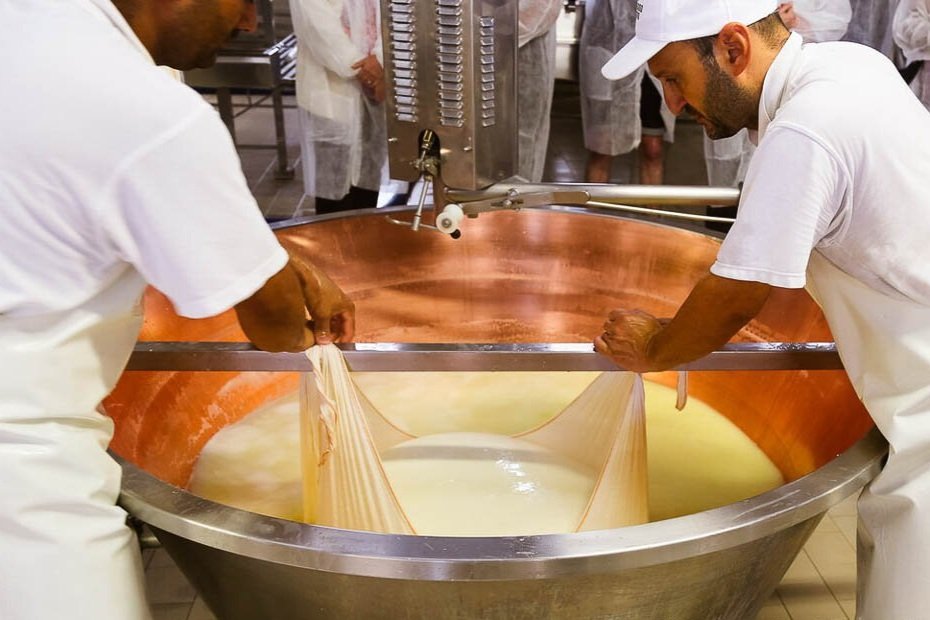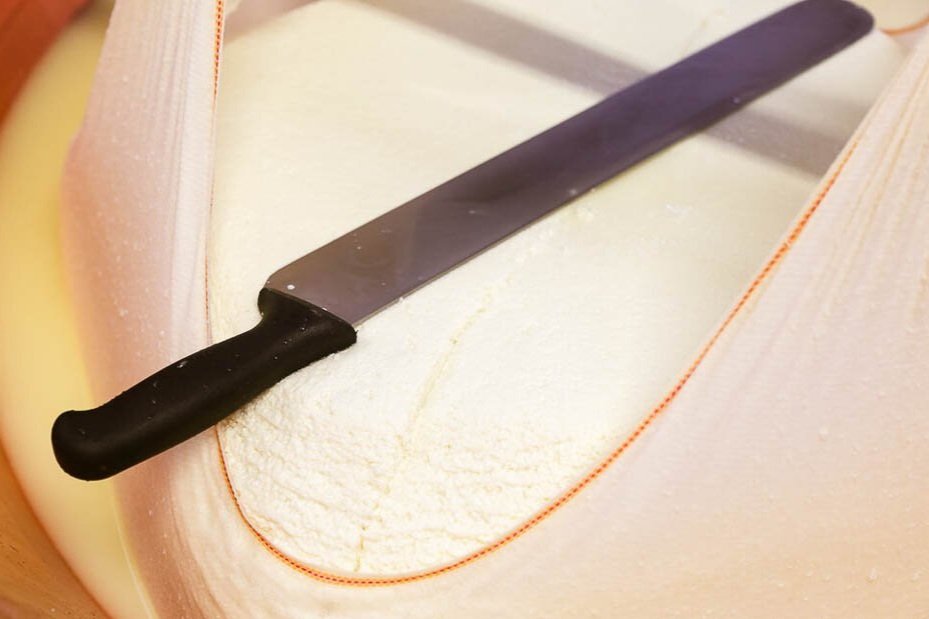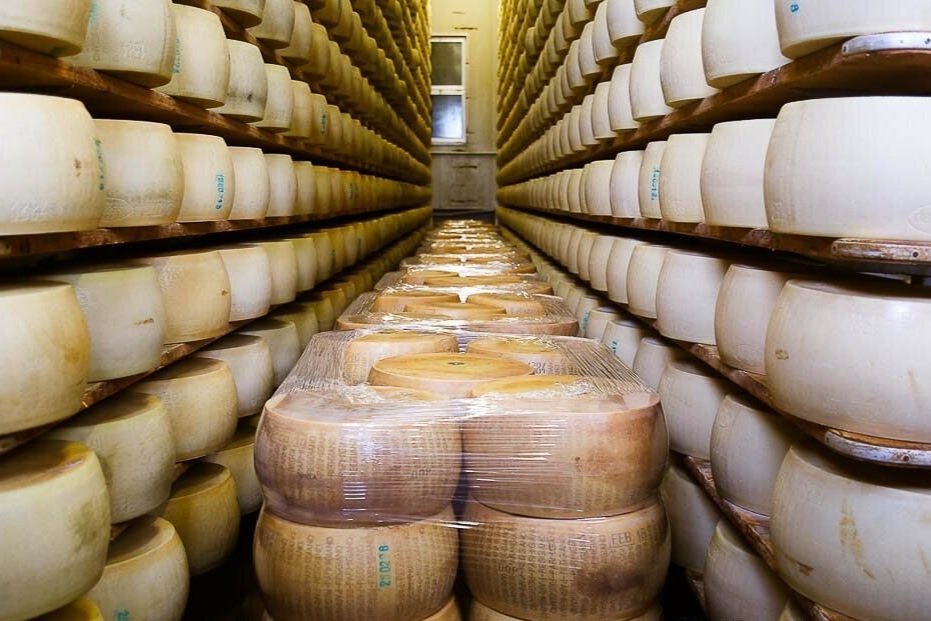Parmigiano Reggiano Cheese: Becoming The Undisputed King Of Cheese
Think you know Parmigiano Reggiano cheese? Hint: it doesn’t come in a can!
I can’t really tell you what’s in the can of cheese in your fridge, but I can tell you this. It’s not the real deal, and it may not even be cheese.
Am I a bit of cheese snob? Possibly, but you can’t blame me. It’s what happens to you when you visit Italy, or France, or any country famous for making cheese, and you begin learning about cheese and how it’s made.
There are around 2,500 unique types of cheese made in Italy, but the undisputed King of Cheese has to be Emilia Romagna’s own Parmigiano Reggiano.
And taking a food tour and learning how this heavyweight is made is a real bucket list experience for foodies planning on visiting Emilia Romagna.
Parmigiano reggiano cheese is sharp and nutty, with crystals that add some texture. It’s not soft enough to slather on crusty Italian bread. If fact, you don’t need bread at all.
So are you ready to learn about the King of Cheese? Then llllllllet’s get ready to rum-ble….!
Parmigiano Reggiano Cheese
Parmigiano Reggiano cheese, regulated by the Italian government's strict DOP guidelines, is not only one of the most famous regional foods of Modena, it’s one of the most traditional foods in Italy.
We got an education about cheesemaking in Bologna, where recognizing and appreciating quality is the key ingredient of the Italian Days food tour we took while we were there. Well that, and an amazing food feast at the end of the tour. ;-)
What’s in this Article?
DOP Parmigiano Reggiano in Italy
Parmigiano Reggiano vs Parmesan: What’s the Difference?
Making Parmigiano Reggiano Cheese
Aging Parmigiano Reggiano
DOP Parmigiano Reggiano in Italy
Making Parmigiano Reggiano is truly a labor of love. It’s created daily by artisans who’ve been making it for generations. It takes over a decade to produce and just a second to wash down.
Together with the famous aged prosciutto hams and traditional balsamico di Modena, these three foods are like the Holy Trinity of foods — some of the most famous foods in the country all produced in Emilia Romagna.
But Parmigiano cheese isn’t just made from cow’s milk. DOP Parmigiano reggiano cheese is made from local Emilia Romagna cows, who only eat local feed produced in Emilia Romagna.
Italians know and live the concept of “you are what you eat”, even when it comes to their cows. What they eat influences their milk, which flavors the cheese.
Such thresholds of quality are the hallmark of the country’s DOP guidelines (Denominazione d' Origine Protetta) which in English stands for Protected Designation of Origin, a strict set of government regulations established to ensure total traceability from farm to table.
Rules are enforced by official inspectors throughout the entire production process.
Blessed are the cheese makers!
Parmigiano Reggiano vs Parmesan: What’s the Difference?
When it comes to cheese, Italians have a saying — “essere la ciliegina sulla torta”, it’s like the icing on the cake! A generous shaving of Italian hard cheese makes any dish better from pasta dishes, salads, or a hearty soup.
Simply put, a cheese can only be called Parmigiano reggiano when it is produced in the cities of Bologna, Mantua, Modena, or Parma, Italy.
The city’s name will be pressed into the rind whereever the cheese wheel is produced.
Parmesan cheese on the other hand is the Anglicized version of parmigiano reggiano, and the word is more commonly used in the US by those who find parmigiano reggiano hard to say. Which is understandable, unless you developed an ear for the Italian language as a kid like many Italian-Americans.
But there is also a quality distinction to be made. Parmesan cheese is often the lesser-grade cheese that doesn’t meet DOP standards.
While some “parmesans” may taste perfectly fine, they are primarily used as grated cheese.
Making Parmigiano Reggiano Cheese
Taking a tour of a parmigiano reggiano cheese factory in Emilia Romagna will ruin you for forever for one of Italy's most iconic foods, but in the best possible way. It’s the perfect introduction to Bologna for foodies.
Most tours also include a tasting at a Balsamic vinegar acetaia and usually a wine tasting or two, because what is cheese and vinegar without some bread and wine! I promise you'll be a Parmigiano cheese convert and certified Italian cheese snob when the day is done.
The plant we toured is operated by just six men who begin the day’s first round of production at 4:30am. Parmigiano cheese production is labor intensive to say the least.
DOP Parmigiano reggiano cheese is made with 100% cow’s milk from local cows raised in Emilia Romagna, who graze on only local feed.
Cooking Cow’s Milk
The Casaro, or Master Cheesemaker, is the conductor of the cheese making process — the person who maintains the timing and the required temperatures — and begins cooking the cow’s milk early, early, early in the morning.
By the time we arrived at 7:30am, the process had long since begun.
The cow’s milk is cooked and then rennet (an enzyme typically found in hooves) is added to form curds. The milk curd is continually circulated and after the mixture reaches a certain temperature and consistency, curds begin to form.
As more and more curds are formed, the curds are eventually gathered up in cheesecloth and separated from the whey (a bi-product of cow’s milk), to form the initial ball of cheese.
Gathering Curds
The curd ball is suspended in cheesecloth above the whey. Each ball is cut in two and makes two 110 lb (55 kilo) wheels.
Making DOP Parmigiano Reggiano is serious business in Italy. Even the farmers who supply the milk for just one wheel of cheese — 550 liters of milk (145 gallons!) — are under the control of the consortium and DOP regulations.
Forming the Cheese
The curd ball is then placed in plastic moulds for one day to form the wheel. After that, a plastic belt with all the information pertaining to the Consortium production plant is placed around the cheese.
The information on the plastic is what tells the origins of the cheese — the date of production, Consortium number, and other info — so consumers know exactly what they’re buying.
The cheese wheels are then placed in stainless moulds for one more day. After this, cheese wheels are removed from the stainless moulds and sit in a saltwater bath for 18 days.
Once the morning tasks are completed, usually around noon, the men go home to rest only to return at 4:30pm to start the next steps in the process.
Aging Parmigiano Reggiano
Aging Process
After the cheese wheels are cleaned and dried, the aging process can begin. Wheels are set on wooden shelves in a humitidy- and temperature-controlled room for a mandatory minimum of 12 months to age. during that time, the wheels are occasionally turned, rotated, and lightly washed.
The white wheels on the shelf (below) show the cheese is fairly young.
After all is said and done — from milking the cows, processing, and aging it 12 months and longer, to final inspections — there is the birth of the King. These aged wheels below have passed the DOP inspection and certification.
Cheese Inspection
Every several months, a certified DOP Cheese Inspector comes to the production facility to inspect the cheese. He look for mold, spoilage, and taps the cheese rounds to ensure there are no air pockets.
The cheese wheels that don’t pass the DOP criteria but are still edible are sold as lesser-grade cheese than DOP.
Tasting Aged Parmigiano Reggiano Cheese
It’s hard to believe that learning more about the making of Parmigiano Reggiano actually made me love the product. Before this, I wasn’t a big fan of grated cheese on anything. I think it was primarily because I was tasting a cheese of lesser quality.
To me, this type of hard cheese always tasted soapy and much too sharp for my taste, like provolone.
After the tour however, and tasting what a good quality Parmigiano Reggiano cheese should taste like, I had a greater appreciation for the taste and what goes into the making of it.
Also, like tasting any cheese tasted at the source, you learn to taste what the animals grazed on and appreciate why it tastes the way it does.
After the tour, we stepped outside for a tasting, but not just of the cheese. There were other local specialties as well — salami on crusty Italian bread, little slices of homemade pizza, and a glass of Lambrusco wine, which to our delight cut the richness of the cheese very well.
***
If you’re planning a visit to Italy, make sure to visit Modena in Emilia Romagna and take a cheese tour. It will change the way you think of cheese!








